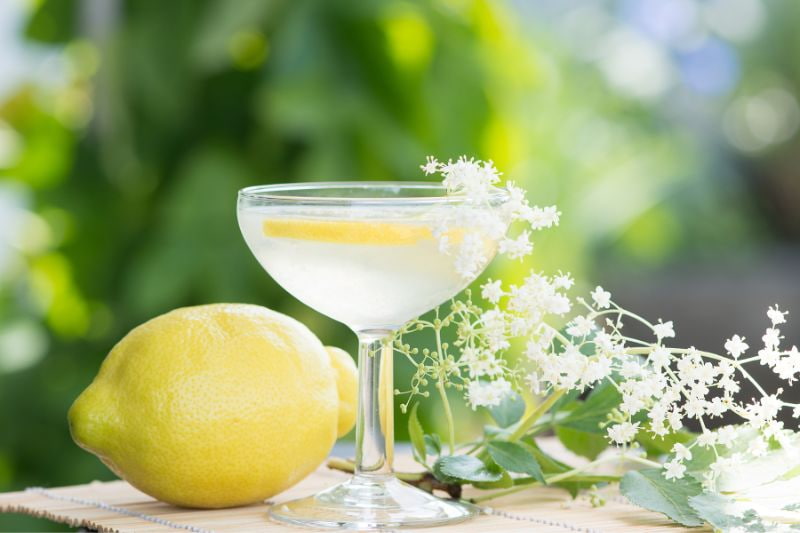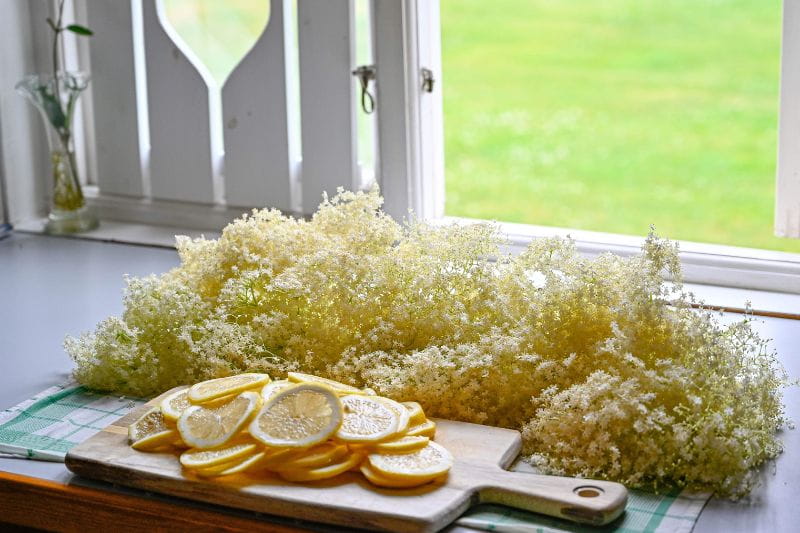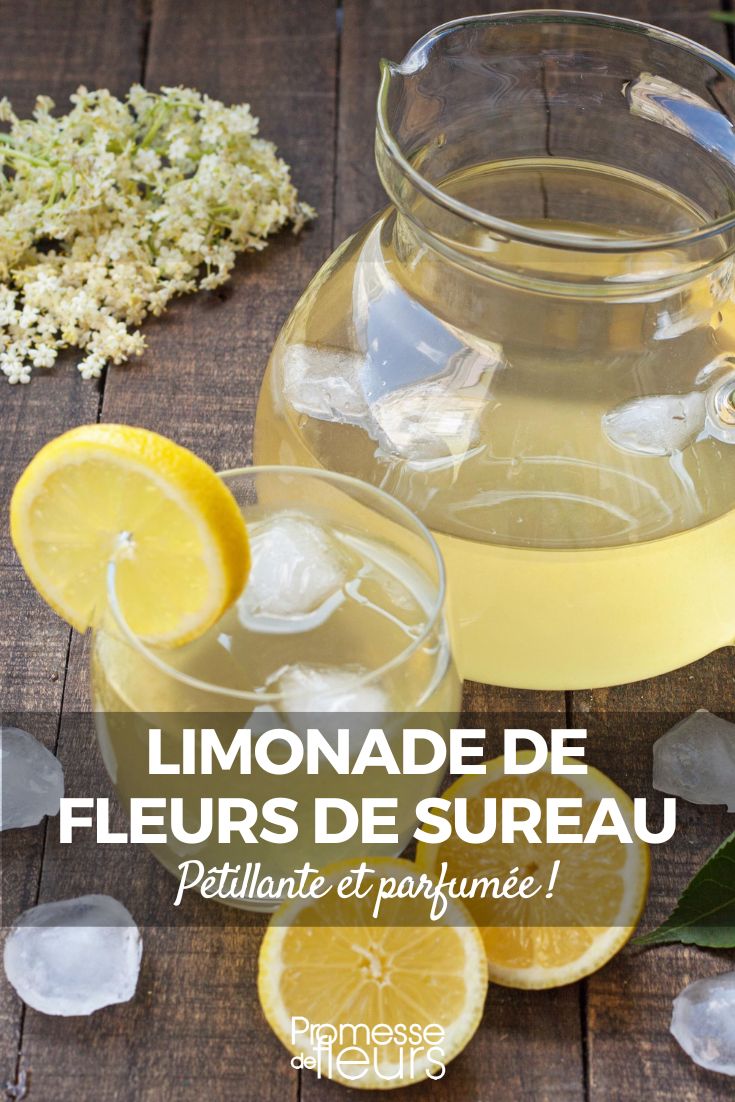Ah, lovely month of May! Spring is already well advanced. Trees and bushes have turned green, flowers release their intoxicating scents, birds are singing... In the garden as in nature, May marks the flowering period of the elder black, a flowering that continues into June. It’s the perfect time to harvest the inflorescences, white or pink depending on species and varieties, and use them in desserts such as elderflower fritters, a cream, pancakes, ice cream, a tart... But elderflowers are also the base of the "fairy champagne", a lightly sparkling, fragrant and very refreshing lemonade.
I’m sharing my recipe for this elderflower lemonade that should delight your friends and family, served as an aperitif.

For more information: Elder: planting, growing and pruning
What exactly is elderflower lemonade?
Elderflower lemonade is a 100% natural drink made from the flowers of the black elder (Sambucus nigra) which grows wild in the countryside or is easily cultivated in gardens. This bush with deciduous foliage generally flowers in May and June–July in beautiful corymbs that are white or pink depending on species. As the name suggests, elderflower lemonade is a fizzy, refreshing and wonderfully aromatic drink.
It is a typically spring beverage whose fizz comes from fermentation. It is this sparkle and its pale colour that have earned it the poetic nickname "fairies' champagne". The term champagne is in quotation marks, firstly because it is a registered name, and secondly because this lemonade is not champagne. Nevertheless, fermentation develops a natural alcohol content of around 1 to 2%. It is therefore a drink not recommended for children, to be enjoyed by adults only!
Harvesting elderflowers
To make this very aromatic lemonade, the first step is to harvest the elderflowers. If you are lucky enough to have a black elder or a hybrid elder variety with pink flowers such as Sambucus nigra ‘Black Tower’, ‘Black Beauty’ or ‘Black Lace’ in your garden, picking will be easy. Harvest your corymbs in the early morning, still haloed by the dawn.
Otherwise, it’s fairly easy to walk the countryside to find a black elder, a bush that grows naturally in most regions, in hedgerows or on riverbanks. Depending on weather and growing conditions, it also flowers between May–June and July.
Now is the time to dispel the reputation for toxicity that still circulates about black elder. Black elder (Sambucus nigra) is absolutely not toxic; flowers and berries are perfectly edible. By contrast, another elder, dwarf elder (Sambucus ebulus), is toxic because of its vomiting and laxative properties. It is therefore essential to know how to tell them apart:
- Black elder is a bush or tree, dwarf elder an herbaceous plant with green stems
- Black elder flowers from May until the end of June, dwarf elder flowers rather in mid‑summer, from late June into July. In addition, the anthers of dwarf elder flowers are pink, those of black elder are cream white.
So, when harvesting elderflowers between May and June, you are unlikely to encounter dwarf elder in flower!
Ingredients for the 'fairy champagne'
- One litre of still mineral water, spring water or tap water
- 4 to 5 large elder corymbs
- 120 g light or brown organic sugar
- 1/2 organic lemon
- 1 tablespoon apple cider vinegar

You will also need a glass carafe or large jar, a muslin cloth or gauze, an elastic band, a sieve and a wooden spoon.
Depending on personal taste, you can always increase or decrease the amount of sugar or lemon.
Preparing the elderflower lemonade
- Shake the elderflowers to remove any insects that may be hiding among them. Then pick the flowers from the stems and set the stems aside, as they are too bitter
- In your chosen container, pour in the water and sugar and stir. Once the sugar is fully dissolved, add the vinegar, the lemon cut into quarters with the peel and the elderflowers. Stir well with your wooden spoon to combine the ingredients
- Cover the container with the fabric or gauze, held in place with an elastic band.
Your container should be placed in a bright room with a temperature between 20 and 25 °C to encourage fermentation. Avoid direct sunlight, which can cause rotting.

This fermentation lasts between 3 and 5 days. It is essential to stir your mixture twice a day for the entire fermentation period. Your lemonade is actually ready when the first bubbles appear. The liquid will naturally become cloudy. It is then time to strain and bottle.
What's next?
- Remove the lemon and elderflowers and strain the drink through a sieve
- Transfer your elderflower lemonade into a bottle with a hermetic mechanical closure, such as certain beer bottles or artisan lemonade bottles, or screw‑top bottles. This lemonade gives off a lot of gas and fermentation continues in the bottle. Avoid cork stoppers, which are not strong enough to withstand the pressure
- Place your bottle in the fridge and wait one to two weeks before tasting so that carbonation continues. Take care to open the bottle occasionally during this time.
This lemonade can be kept for one to two months in the fridge.

Flavour variations
To add some colour to elderflower lemonade, you can add other edible flowers during fermentation such as poppy or hibiscus petals. Some people also add raisins or dates. Adding a few leaves of aromatic plants such as mint or basil, or a few sprigs of rosemary can also provide an extra aromatic touch.
Spices such as cinnamon or cardamom pair very well with the flavours of this lemonade. But use sparingly.
Finally, don’t hesitate to serve your 'fairy champagne' in pretty glasses with a few strawberries, raspberries or blackcurrants.
































Comments